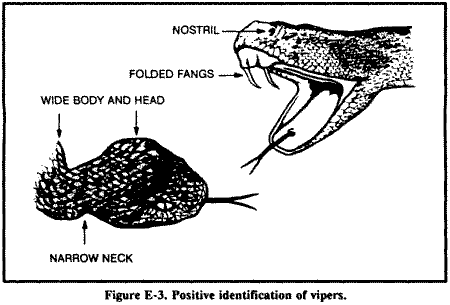Yes, thats none else than the Russell's Viper(Vipera russelli).
Russell's viper(Vipera russelli)is an extremely venomous, brightly colored, viperine snake of southeastern Asia and Indonesia.

(A mating pair of Russell's viper, resting on Aloe vera bush, in the broad day light)
A VIPER is a venomous snake, especially any member of the families Viperidae (true vipers) and Crotalidae (pit vipers).(The viperidae or true vipers usually have thick bodies and heads that are much wider than their necks. However, there are many different sizes, markings, and colorations.)

(**A note on the way vipers deliver their hemotoxic venoms into their prey's body)
This dangerous species,Vipera russelli, is abundant over its entire range. It is responsible for more human fatalities than any other venomous snake. It is irritable. When threatened, it coils tightly, hisses, and strikes with such speed that its victim has little chance of escaping. Its hemotoxic venom is a powerful coagulant, damaging tissue and blood cells.
Distributed predominantly in Sri Lanka, south China, India, Malaysian Peninsula, Java, Sumatra, Borneo, and surrounding islands, this species of viperine snake grows up to an avg. of 1 meter and max up to 1.5 meters. Habitat is variable ranging from farmlands to dense rain forests. Common food is rats, rodents, lizards and frogs, at times may be small passerine birds also. It is commonly found around human settlements, under broken walls, in stores-granaries, in garage, in compound wall's cracks, in all those suspectible places where it can mimic nicely and make a wise man be fooled.
Russell's viper's venom is used as a coagulant in the arrest of hemorrhage from accessible sites in hemophilia.The venom of Russell's viper acts in vitro as an instrinsic thromboplastin and is useful in defining deficiencies of blood clotting factor X.
(** A note on the way Viper's work on their prey)
Over the span of time , as evolution proceeded, this snake group Viperdae's members developed a highly sophisticated means for delivering venom. These true vipers are associated with long, hollow fangs that perform like hypodermic needles,thus delivering the venom deep into the wound.
The fangs of this group of snakes are movable. These snakes fold their fangs into the roof of their mouths. When they strike, their fangs come forward, stabbing the victim. The snake controls the movement of its fangs; fang movement is not automatic. The venom is usually hemotoxic. There are, however, several species that have large quantities of neurotoxic elements, thus making them even more dangerous. The vipers are responsible for many human fatalities around the world.









No comments:
Post a Comment